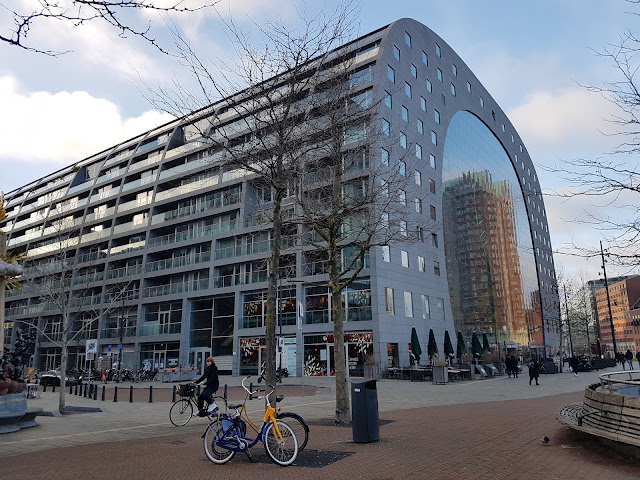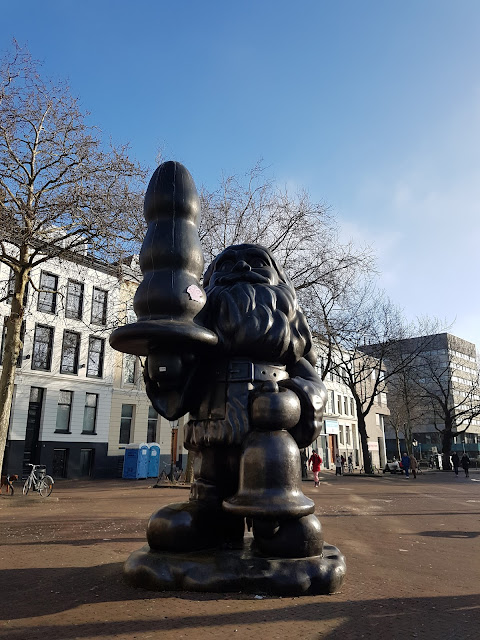Rotterdam is easily reached from London by Eurostar on the Lille-Brussels line, the train continuing to Amsterdam. Unlike the latter’s incongruous balance of cosy, gezelligheid ‘brown cafés’ and sordid stag nights, this city is at once industrial and elegant, and packed with diverse architectural styles. Rotterdam, c’est la classe.
 |
| The cube houses overlooking the Old Harbour |
The okay hostel’s USP, was, of course, in staying inside one of the cube houses. The first thing that struck me, as an adopted Londoner, was the sheer inefficiency of space inside. The cube houses were built in the 70s by architect Piet Blom with the dreamy concept of presenting domestic life in an urban forest: the tilted cubes forming a treetop canopy, and the central staircase up into each cube, the trunk. The fundamental problem is that gravity continues to work as expected on the inside as it does on the outside. This means that regular furniture remains on the floor but does not fit against the walls, huge underhanging corners are left empty and unused, windows slant far away from one’s line of vision, and acute angles encourage acute neck pain if one gets too close to an overhanging wall.
Accommodation in Rotterdam is expensive, which is why I opted for a hostel dorm. However, there’s always a trade-off to be had when electing for cheaper accommodation, and in this case it was the city’s top-notch cuisine.
Rodin Café Restaurant off the east end of trendy Witte de Withstraat is highly recommended. The staff were friendly and attentive, the space was nicely decorated with a thoughtful use of 90 degree angles, and the menu was inventive and fresh. Rodin offers a three-course prix fixe menu for €33, or you can skip pudding for a lower price if you’ve only recently waffled. My starter was marinated raw cod with sesame and peppercorns, alongside fresh, jelly-like seaweed the colour of dappled sunlight through a glade. The main was a pleasingly simple fried plaice with buttered baby potatoes, spinach, and fennel. My waitress described the dessert as ‘I can’t explain, it’s a Dutch thing’: it was a hearty coconut macaroon served with cream and a deliciously sour cassis coulis.
I encountered ‘I can’t explain, it’s a Dutch thing’ several times in the Netherlands, and I always ordered whatever it was so I could find out. A waiter in Amsterdam struggled to explain the staple dish Stamppot to me, so naturally I chose it immediately. (Stamppot is essentially mashed potato with anything that’s been lying around in the fridge for a while and needs to be used up, and topped with similar). The same thing happened with jordaansebal in the ‘dam district of Jordaan – it turned out to be a type of small, well-seasoned beef meatloaf, sometimes shot through with sticks of melted gouda.
On the same street as Rodin there is Bazar, a Turkish place bright with hanging lamps. It was always packed when I passed, and I couldn’t get a table when I tried at the weekend. Several cosy pubs and restaurants line Witte de Withstraat, and there's a ‘coffee shop’ (cannabis establishment) too, for those who like their jazz cigarettes.
 |
| Beautiful wows |
Also recommended is the unlikely looking neon-lit WOW CRAB. I ate at the original WOW in the Old Harbour; there’s now a second venue opposite the Markthal, and one in Amsterdam too. Hoping for beautiful wows, like I was promised by an amusing Google Translate review of a place in Andijan, Uzbekistan, and clawed in by the promise of a seafood-only restaurant, I was impressed. My waitress instructed me to place my order via my phone, but in exchange for this technological fripperie, a cold drink appeared within 20-30 seconds of my having pressed Go. I selected cajun fries and 400g of clams, which came with a choice of sauces: garlic butter, lemon pepper, spicy cajun, or ‘WOW’; a mad mix of all three. The unfortunate creatures arrived in a large boil-bag with baby potatoes and corncob, all carefully emptied onto my paper tablecloth by a jolly waiter in a naval jacket. I recommend bringing a friend or two so a wider seafood selection can be sampled: the table next to me feasted on a large bag of whole crab, langoustines, scallops, calamari and crevettes. There was also an ‘anti-inflation’ menu option of 200g large shrimps, potatoes and corn for a tenner. This was good, fresh seafood at accessible prices.
 |
| Markthal |
The Markthal also can’t be missed, literally: this vast hangar squats in the Grotemarkt and houses offices and restaurants in the building structure itself, and food stalls in the space inside. There are fresh fish shops with menus far more varied than our haddock/cod/plaice places at home. For pudding there are handmade chocolates, hot waffles with cream, stroopwaffels with caramel, or poffertjes; tiny drop-pancakes served with melted salty butter and icing sugar. If you’re not sure how to pronounce poffertjes, it is said as if you already have one in your mouth and it's very hot.
On your museum day (not Monday), head to the Museumpark to visit the Kunsthal or the striking Depot Boijmans van Beuningen. The latter in particular must not be missed; this depot housing over 150,000 Dutch art pieces including paintings, sculptures, ceramics, and glassware, is the world's first publically accessible art storage facility, and is itself a work of art.
 |
| Depot Boijmans van Beuningen |
 |
| The Lego building as seen from the Erasmus Bruge |
Save your outdoor activities for Monday when the museums are closed. In the morning, enter the Old Port underneath the yellow cube houses, and pass the bright red light Vessel 11 around to the historic dockyard near the Maritime Museum. The iconic Erasmusbrug (the bridge named after the Dutch philosopher) is a good vantagepoint for the Lego building and the skyline of Rotterdam’s Wilhelminapier, with the old headquarters of the Holland-Amerika Lijn. Staying on the northern side, follow the promenade round to the pleasant Het Park, which is full of straight people (joke) and their well-behaved dogs. The tall Euromast observation tower overlooks the park and you can take an elevator up to the top and look out from the observation deck for all the benefits Brexit has brought about (answer: exactly none). If it’s cloudy and you’re not keen on heights, stop instead at the Grand Café Loos for coffee and chocoladetruffeltaart. Continue to the pretty, historic district of Delfshaven, one of the few districts to survive the 1940 bombardment.
 |
| The Buttplug Gnome |
Another important cultural icon of Rotterdam is the Buttplug Gnome on Eendrachtsplein, and let’s not pretend it’s supposed to be Santa Claus fisting brandishing a Christmas tree. Even the American sculptor Paul McCarthy refers to the inclusion of the buttplug itself as a critique of yuletide mass consumerism. Indeed, he had no problem with his masterpiece being likened to a festive sex toy; in fact, he was gifted a buttplug in the early 70s which he kept on his desk next to a little elf. The unveiling of the Buttplug Gnome was ceremoniously completed by a man hanging from a crane suspended by hooks through his skin. If you’re fond of puns you can opt to stay in the neighbouring Hotel Unplugged. Also nearby is the queer-friendly Coffee Company which has good cakes and squashy armchairs.
Rotterdam is Europe’s largest harbour, and the sheer scale can only be appreciated on a boat. Spido offers a 75 minute harbour tour for €16.75 which takes in the Rotterdam skyline, the working port and a view of container ships being un/loaded, and a good view of the elegant ‘Grande Dame’, the SS Rotterdam, the former ocean-liner of the Holland-Amerika Lijn.
I spent three days in Rotterdam, and I like to explore rather slowly, but if you like to pack in your activities you could probably fit most of this into two very long days.
If you enjoyed this post, you can follow me to receive new posts by email. Thank you for reading!
Or see more posts here: Get in the tuktuk, no time to explain



Comments
Post a Comment